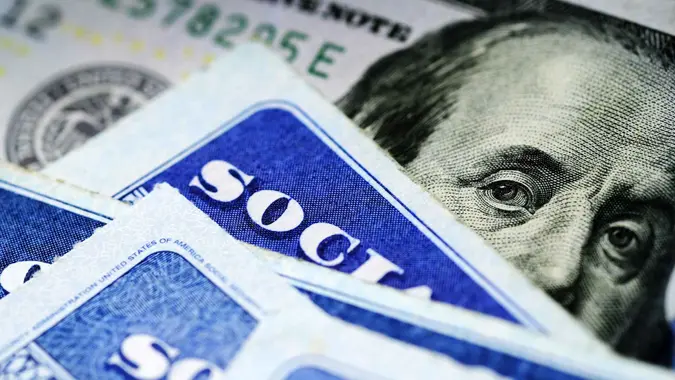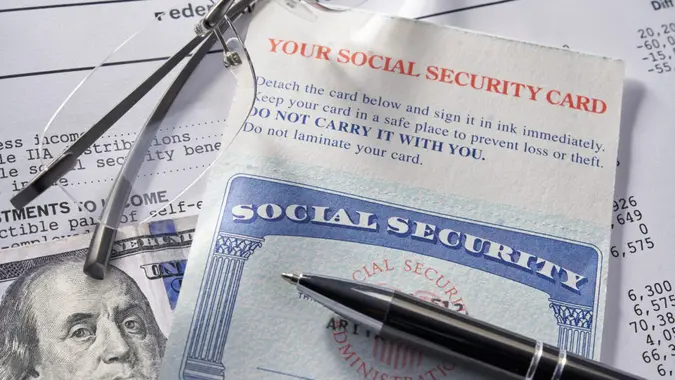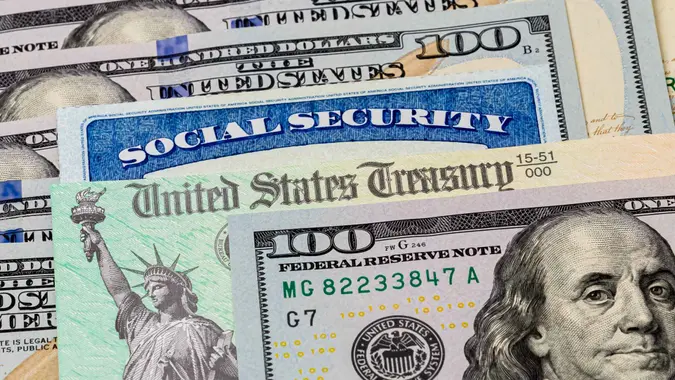How Big Is the Average Social Security Check of a Retiree in the 1%?

Commitment to Our Readers
GOBankingRates' editorial team is committed to bringing you unbiased reviews and information. We use data-driven methodologies to evaluate financial products and services - our reviews and ratings are not influenced by advertisers. You can read more about our editorial guidelines and our products and services review methodology.

20 Years
Helping You Live Richer

Reviewed
by Experts

Trusted by
Millions of Readers
According to Fortune, earning $650,000 per year in America is enough to make you a “one-percenter,” although the exact number varies from state to state. If someone is earning that type of money as a retiree, they’ll also be earning a hefty Social Security check.
This may seem unnecessary, as those types of earners obviously don’t “need” a Social Security payout — but that’s not how Social Security retirement payouts work. Rather than being based on need, they are determined mathematically. Those who pay the highest amount of taxes into the Social Security system — the one-percenters — also reap the biggest rewards at retirement.
Here’s a look at exactly how this calculation works and what a retiree in the 1% can expect to earn.
How Social Security Payouts Are Calculated
Social Security retirement payouts are based solely on two things — your earnings record and the age at which you file for benefits. Need doesn’t play a role in this calculation.
The Social Security Administration takes your highest 35 years of earnings to determine your primary insurance amount, or PIA. This amount is paid out if you file for benefits at your full retirement age, which is 67 for those born in 1960 or later. If you file at any age before full retirement age, your payout is reduced — by as much as 30% if you file at the earliest-possible age of 62. If you wait until after full retirement age, your benefit will increase by 8% per year until age 70.
What Is the Social Security Wage Base?
The Social Security wage base is important to understand if you are a high earner because it limits both the amount of taxes you have to pay and the potential benefit you can earn. Taxes for old-age, survivors and disability insurance, or OASDI, amount to 12.4% of your income. However, your employer is responsible for half of that amount, meaning only 6.2% actually comes out of your paycheck.
The wage base, also known as the benefit base, limits the amount of your income on which you have to pay that 6.2% tax. This amount is adjusted annually for inflation. For 2023, the limit was $160,200, while for 2024 it rises to $168,600.
Average Social Security Payout for the 1%
As the wage base is far below the average one-percenter income of $650,000, it means that the wealthiest earners pay the absolute maximum amount of Social Security tax. With a 6.2% tax on the wage base of $160,200, this means that the top earners paid $9,932.40 in OASDI taxes in 2023.
In return, the highest earners — and by definition, those paying the most tax — also earn the highest Social Security benefit.
For 2023, the maximum possible monthly payout was $4,555. The Social Security Administration doesn’t break down payouts by average income level, but it’s likely that a number of one-percenters earned that amount.
It’s important to note, however, that even among the one-percenters, it’s hard to earn the maximum possible Social Security benefit. For starters, you would have to earn at least the wage base limit for 35 solid years, without a single year dipping below the limit. Even those earning millions by their peak earning years don’t always start out with a six-figure salary on day one. In fact, according to the Social Security Administration, only 6% of workers in any given year earn above the wage base.
Additionally, to get that top payout, you’ll also have to wait until age 70 to file for benefits. While most one-percenters don’t “need” Social Security and can therefore afford to wait that long, not all do.
Comparison With the Average Social Security Payout
While Social Security sometimes gets a bad rap for not paying enough to finance retirement, the top payout is actually quite healthy. If you earned the maximum $4,555 benefit per month, you’d be pulling down $54,660 per year. That’s more than the average working American in states like Mississippi and West Virginia earned in 2023, and it’s close to the 2023 national average salary of $59,428, according to Bureau of Labor Statistics data.
Unfortunately, average earners in the U.S. will never draw anything close to that maximum possible Social Security benefit. In fact, as of Nov. 2023, the SSA reports that the average benefit for retired workers was just $1,844.76, or $22,137.12 per year.
This means that a one-percenter earning the maximum $4,555 monthly benefit earns roughly 2.5x the average Social Security retiree payout.
More From GOBankingRates
 Written by
Written by  Edited by
Edited by 

























